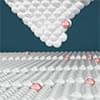Jul 25, 2024
In vivo magnetogenetics for cell-type-specific targeting and modulation of brain circuits
Posted by Logan Thrasher Collins in categories: biotech/medical, genetics, nanotechnology, neuroscience
Minimally invasive cellular-level target-specific neuromodulation is needed to decipher brain function and neural circuitry. Here nano-magnetogenetics using magnetic force actuating nanoparticles has been reported, enabling wireless and remote stimulation of targeted deep brain neurons in freely behaving animals.


















